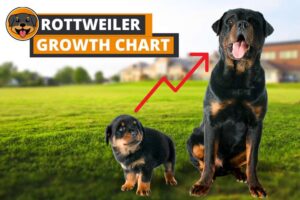Have you ever wondered what goes on in the life of a Rottweiler during its heat cycle? Can you imagine the rollercoaster of changes that happen within a Rottweiler’s body during this time?
In this article, we will cover everything you need to know and do when your rottweiler is in heat.
Rottweiler Heat Cycle – What is it?

A heat cycle, or estrous cycle, is a natural biological process that occurs in female Rottweilers (and other mammals) to prepare their bodies for potential pregnancy.
During this cycle, hormonal changes happen within the dog’s body, leading to physical and behavioral changes.
The heat cycle plays a vital role in the reproductive process, ensuring that the Rottweiler population continues to thrive.
The Rottweiler heat cycle consists of four main stages, each with its own distinct hormonal changes, physical signs, and behavior patterns.
The stages are proestrus, estrus, diestrus, and anestrus. These stages follow one after another, and together they make up a complete cycle that repeats itself throughout a Rottweiler’s reproductive life.
When do Rottweilers go into heat for the first time?

Rottweilers, like all dog breeds, experience their first heat cycle at different times, depending on various factors such as genetics, overall health, and environmental conditions.
Generally, a female Rottweiler will go into heat for the first time when she reaches sexual maturity, which typically occurs between 6 and 18 months of age.
However, it’s essential to remember that each dog is unique, and some Rottweilers may experience their first heat slightly earlier or later than this age range.
Smaller Rottweilers might tend to reach sexual maturity earlier, while larger Rottweilers may take a bit longer. It’s crucial to monitor your dog closely during this period to recognize the signs of her first heat and provide the necessary care and attention.
If you’re concerned about your Rottweiler’s development or her first heat cycle, it’s always a good idea to consult your veterinarian.
They can offer guidance and advice based on your Rottweiler’s individual needs, ensuring she remains healthy and comfortable throughout her first heat cycle and beyond. You can read this article to know more about when do rottweilers go into heat for the first time.
How Long Do Rottweilers Bleed When in Heat?

stage of her heat cycle, known as proestrus. During this stage, the dog’s body prepares for potential mating and pregnancy.
The bleeding is a result of the lining of the uterus thickening and the increased blood flow to the area.
The duration of bleeding can vary from one Rottweiler to another, but generally, Rottweilers bleed for about 7 to 10 days during the proestrus stage.
However, this can sometimes be shorter or longer depending on the individual dog. It’s important to monitor your Rottweiler closely and observe any changes in the bleeding, as this can help you understand her unique heat cycle pattern.
The bleeding typically starts as a dark red or brown discharge, which may be heavier at the beginning of the proestrus stage.
As the heat cycle progresses, the discharge may become lighter in color and consistency, transitioning to a pinkish or straw-colored discharge during the estrus stage, when the dog is receptive to mating.
Keep in mind that some Rottweilers may experience minimal bleeding or discharge that may not be easily noticeable.
In such cases, it’s crucial to pay attention to other signs of heat, such as swelling of the vulva or changes in behavior, to determine when your Rottweiler is in her heat cycle.
How often do Rottweilers go into heat?

The frequency of heat cycles in Rottweilers can vary based on individual factors such as age, health, and genetics.
Generally, female Rottweilers go into heat every 6 to 9 months. This means that your Rottweiler could potentially experience one to two heat cycles per year.
It’s important to note that each Rottweiler is unique, and the frequency of their heat cycles may not be consistent, especially during the initial years of their reproductive life.
As your Rottweiler matures, her heat cycle may become more regular and predictable. Monitoring your Rottweiler’s heat cycles and keeping track of the duration and frequency will help you understand her individual pattern better.
In some cases, Rottweilers may experience irregular heat cycles or go into heat more or less frequently than the typical range.
If you notice any significant deviations from the normal pattern or are concerned about your Rottweiler’s heat cycle, it’s a good idea to consult with your veterinarian.
They can evaluate your dog’s overall health and reproductive system to ensure that there are no underlying issues causing the irregularities.
Understanding Rottweiler’s Breeding Cycle
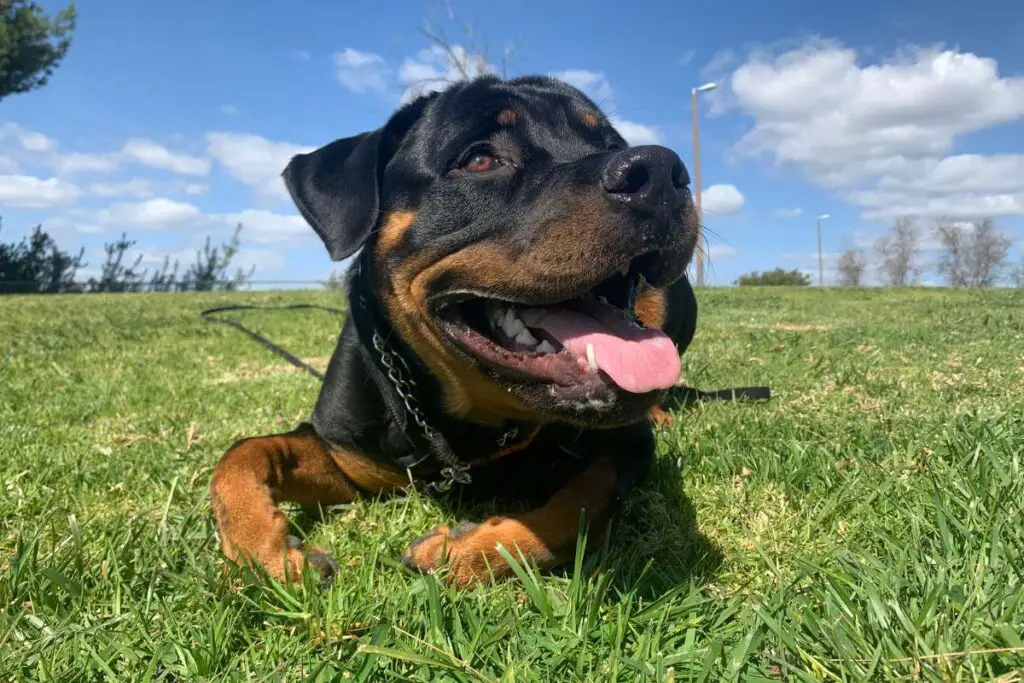
To better care for your female Rottweiler during her heat cycle, it’s essential to understand the different stages involved in the breeding cycle.
Each stage has its unique hormonal changes, physical signs, and behaviors.
Here’s an overview of the four main stages of a Rottweiler’s breeding cycle:
1. Proestrus
This stage marks the beginning of the heat cycle and typically lasts between 7 to 10 days, although the duration can vary.
During proestrus, the female Rottweiler’s body starts preparing for potential mating and pregnancy. Physical signs of proestrus include swelling of the vulva and a bloody discharge.
The dog may also become more affectionate and show increased interest from male dogs. However, during this stage, the female is not yet receptive to mating.
2. Estrus
The estrus stage is when your Rottweiler becomes receptive to mating and can become pregnant. This stage usually lasts for about 9 days, but the duration can range from 4 to 24 days.
The discharge during estrus changes to a lighter pink or straw color, and the swelling of the vulva may slightly decrease.
You may also notice that your Rottweiler is more eager to be around male dogs and may show “flagging” behavior, where she raises her tail to the side to signal her readiness to mate.
Diestrus
The diestrus stage follows estrus and is characterized by a return to normalcy for your Rottweiler. This stage usually lasts about 2 months, whether or not your dog has become pregnant.
During diestrus, the discharge stops, the vulva returns to its normal size, and the dog’s behavior goes back to normal.
If your Rottweiler has become pregnant, this stage will continue throughout her pregnancy and end with the birth of her puppies.
Anestrus
Anestrus is the final stage of the breeding cycle, often referred to as the “resting” stage. This stage can last anywhere from 2 to 6 months, depending on your Rottweiler’s individual cycle.
During anestrus, there are no hormonal or physical signs of heat, and your Rottweiler will not be receptive to mating.
This stage provides a necessary break for your dog’s reproductive system before the next heat cycle begins.
By understanding the different stages of your Rottweiler’s breeding cycle, you can better support her needs, ensure her comfort, and provide appropriate care throughout her heat cycle.
Signs of Heat in Rottweiler
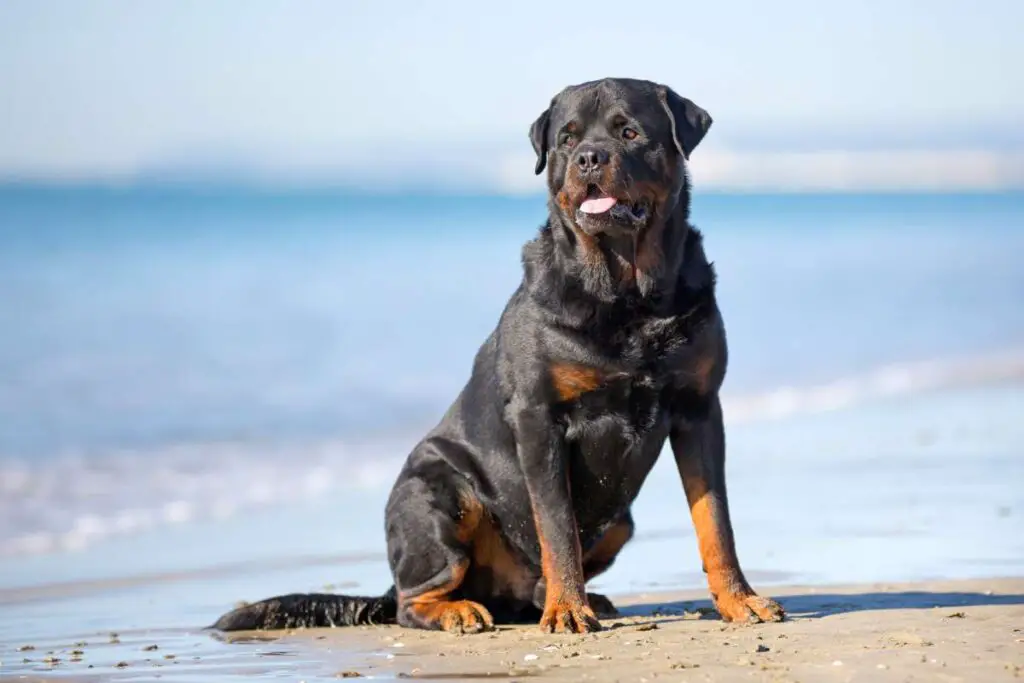
Recognizing the signs of heat in your Rottweiler is crucial for providing her with proper care and attention during this time. Here are some common signs that your Rottweiler might be in heat:
- Swelling of the vulva: One of the first signs of heat is the swelling of your Rottweiler’s vulva. This swelling can be quite noticeable and usually occurs during the proestrus stage.
- Bleeding or discharge: During the proestrus stage, you may notice a bloody discharge from your Rottweiler’s vulva. As the heat cycle progresses into the estrus stage, the discharge may change to a lighter pink or straw color.
- More frequent urination: Your Rottweiler might urinate more frequently during her heat cycle. This is partly due to hormonal changes and also serves as a way for her to mark her scent and signal her reproductive status to male dogs.
- Increased affection or clinginess: Some Rottweilers may become more affectionate or clingy during their heat cycle. They might seek extra attention, cuddles, or physical contact from their owners.
- Behavioral changes: You may notice changes in your Rottweiler’s behavior during her heat cycle, such as increased restlessness, pacing, or whining. These behaviors can be a result of hormonal fluctuations and discomfort associated with the heat cycle.
- Male dogs showing extra interest: Male dogs can detect the scent of a female in heat from quite a distance. If you notice male dogs suddenly showing a lot more interest in your Rottweiler or lingering around your home, it’s likely that she is in heat.
- “Flagging” behavior: During the estrus stage, when your Rottweiler is receptive to mating, she may display “flagging” behavior. This involves raising her tail to the side to signal her readiness to mate.
By recognizing these signs, you can identify when your Rottweiler is in heat and provide her with the necessary care and support during this time.
If you’re ever unsure or concerned about your dog’s condition, it’s always best to consult with your veterinarian for guidance.
Rottweiler’s First Heat Care
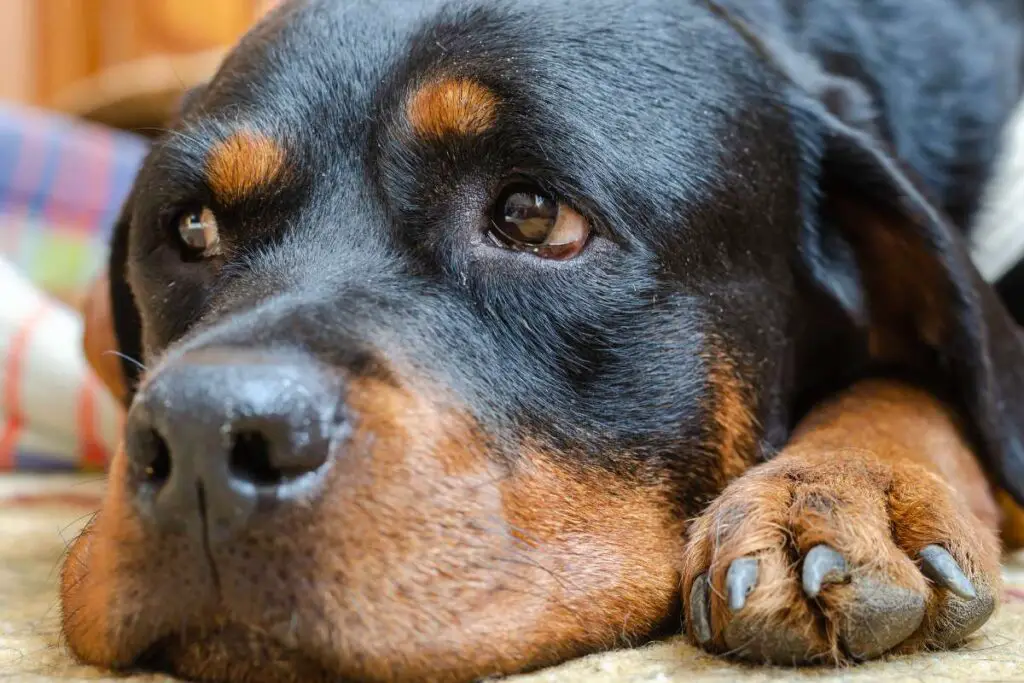
Caring for your Rottweiler during her first heat cycle is essential to ensure her comfort, health, and well-being.
As her owner, you’ll need to pay extra attention to her needs and provide appropriate care during this time.
Here are some tips for managing your Rottweiler’s first heat cycle:.
Monitor her closely
Keep a close eye on your Rottweiler to recognize the signs of her first heat cycle. This will help you understand her unique pattern and be prepared for future cycles.
Provide a comfortable environment
Your Rottweiler may feel more sensitive or uncomfortable during her first heat. Make sure she has a quiet, cozy space to rest and relax in your home.
Keep her clean and dry
Due to the bleeding and discharge associated with the heat cycle, it’s important to keep your Rottweiler clean and dry.
You can use doggy diapers or absorbent pads to help manage the bleeding and keep her comfortable.
Be patient and understanding
Your Rottweiler’s behavior may change during her first heat cycle. Be patient and understanding with her, offering extra love and attention as needed.
Avoid stressful situations
Try to minimize exposure to stressful situations, such as visits to the vet or dog park, during your Rottweiler’s first heat cycle. This will help reduce any additional stress on her body and mind.
Maintain a regular routine
Stick to your Rottweiler’s regular routine as much as possible, including feeding, walking, and playtime. This will help her feel more secure and comfortable during her heat cycle.
Consult your veterinarian
If you have any concerns or questions about your Rottweiler’s first heat cycle, don’t hesitate to consult your veterinarian. They can provide guidance and advice tailored to your dog’s specific needs.
By following these tips, you can help ensure your Rottweiler’s first heat cycle goes smoothly and comfortably.
Remember, your love, care, and attention are key to helping her through this new and potentially challenging experience.
Things Not to Do When Your Rottweiler Is in Heat
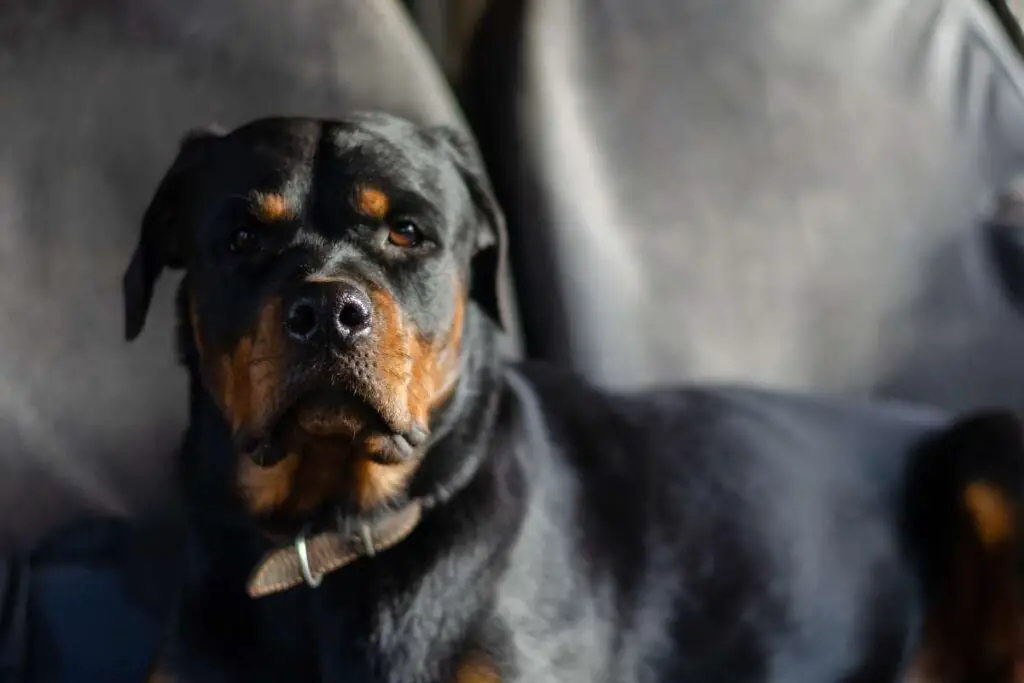
When your Rottweiler is in heat, it’s crucial to be attentive to her needs and avoid certain actions that could cause her stress or discomfort.
Here are some things you should avoid doing when your Rottweiler is in heat:
Don’t let her off-leash
It’s important to keep your Rottweiler on a leash when outdoors, even in familiar areas, to prevent her from wandering off and potentially mating with male dogs.
Avoid dog parks and crowded areas
During her heat cycle, your Rottweiler will attract the attention of male dogs, which can lead to conflicts and unwanted mating.
To prevent this, avoid taking her to dog parks or other crowded areas where she might come into contact with other dogs.
Don’t schedule elective surgeries
Avoid scheduling any elective surgeries, such as spaying, during your Rottweiler’s heat cycle. The increased blood flow and hormonal changes during this time can make surgery riskier.
Consult your veterinarian for the best time to schedule these procedures.
Don’t ignore signs of discomfort or distress
Your Rottweiler may experience discomfort during her heat cycle, so it’s essential to monitor her closely and address any signs of distress promptly.
Consult your veterinarian if you’re unsure how to help her or if her discomfort seems severe.
Don’t force her to socialize
While your Rottweiler may be more affectionate during her heat cycle, she might also feel more sensitive or irritable.
Respect her boundaries and avoid forcing her to socialize with other dogs or people if she seems uncomfortable.
Don’t neglect her exercise
While it’s important to avoid crowded areas and off-leash play, your Rottweiler still needs regular exercise during her heat cycle.
Continue taking her for walks and engaging in low-key play sessions to help her maintain her physical and mental well-being.
Don’t panic
It’s natural to feel concerned or worried during your Rottweiler’s heat cycle, especially if it’s her first time. However, panicking or overreacting will not benefit either of you.
Stay calm, be patient, and consult your veterinarian if you have any concerns.
By avoiding these actions, you can help ensure your Rottweiler’s comfort and well-being during her heat cycle, reducing stress for both you and your dog.
Providing Proper Exercise and Rest

During your Rottweiler’s heat cycle, it’s essential to maintain a balance between exercise and rest to ensure her overall well-being.
Here are some tips for providing your Rottweiler with the right balance of exercise and rest during her heat cycle:
Stick to a regular exercise routine: Maintaining your Rottweiler’s regular exercise routine can help her feel more secure and comfortable during her heat cycle.
Continue taking her for daily walks, but be mindful of avoiding crowded areas or off-leash parks where she might encounter male dogs.
Adjust the intensity of exercise: Your Rottweiler may experience some discomfort or sensitivity during her heat cycle, so it’s a good idea to adjust the intensity of her exercise accordingly.
Opt for gentle, low-impact activities, such as leisurely walks or gentle play sessions, instead of rigorous or high-energy activities.
Monitor her energy levels: Keep an eye on your Rottweiler’s energy levels during her heat cycle. If she seems more tired or lethargic than usual, it’s essential to allow her to rest and recover.
On the other hand, if she appears restless or anxious, a short walk or play session might help relieve her stress.
Provide a comfortable resting area: Ensure your Rottweiler has a cozy and quiet space to rest during her heat cycle. A comfortable bed or designated area in a low-traffic part of your home can help her relax and recuperate.
Offer mental stimulation: In addition to physical exercise, it’s essential to provide your Rottweiler with mental stimulation during her heat cycle. Interactive toys, puzzle feeders, or simple training exercises can help keep her mind engaged and prevent boredom. Here are some mental stimulations for rottweilers.
Pay attention to her cues: Your Rottweiler will likely communicate her needs during her heat cycle.
Pay close attention to her body language and behavior to determine when she needs exercise, rest, or comfort.
Consult your veterinarian: If you’re unsure about the appropriate exercise and rest balance for your Rottweiler during her heat cycle, consult your veterinarian.
They can provide guidance based on her specific needs and overall health.
Final Thoughts
Understanding your Rottweiler’s heat cycle is essential for her health and happiness. By knowing what to expect and how to care for her during this time, you’ll be the best dog parent around!
Just remember to be patient, loving, and attentive – and your Rottie will thank you with lots of wet, sloppy



